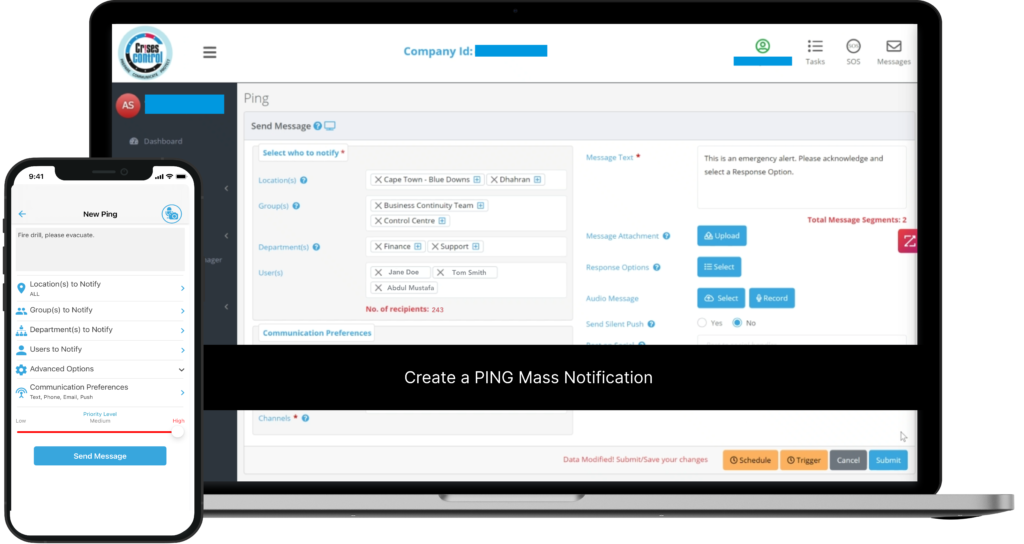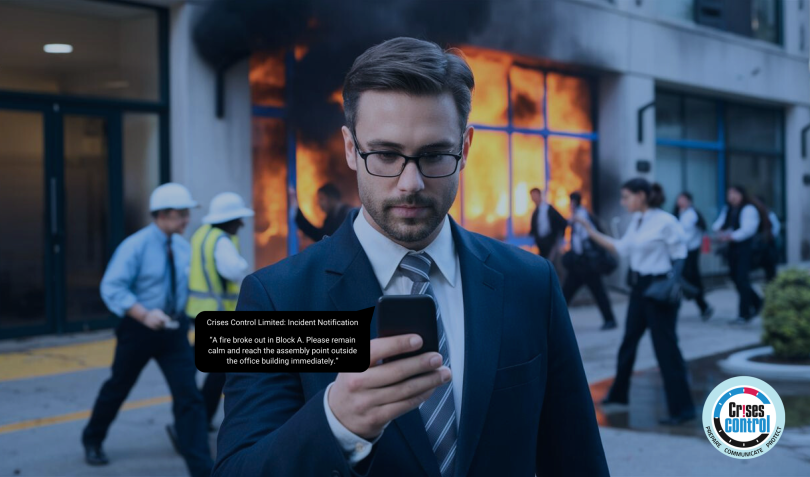Written by Anneri Fourie | Marketing Executive
In today’s unpredictable world, having a robust emergency response plan is not just a regulatory requirement but a business imperative. Emergencies can strike at any moment, and without a tailored plan, your company could face significant risks.
This blog will guide you through the step-by-step process of creating a customised emergency response plan that addresses your business’s unique needs, with a special focus on how Crises Control can enhance your preparedness.
Understanding the Importance of an Emergency Response Plan
Every company, regardless of its size or industry, is vulnerable to emergencies. These can range from natural disasters like floods and earthquakes to man-made crises such as cyber-attacks or industrial accidents. An effective emergency response plan is essential for safeguarding employee safety, ensuring business continuity, and minimising financial and reputational damage.
Step 1: Conduct a Risk Assessment
The first step in creating a customised emergency response plan is conducting a comprehensive risk assessment. This involves:
Identifying Potential Threats
- Natural Disasters: Assess the likelihood of events such as earthquakes, hurricanes, floods, and wildfires in your location.
- Technological Incidents: Consider the risk of cyber-attacks, data breaches, and system failures.
- Human-Caused Events: Evaluate threats such as workplace violence, terrorism, and industrial accidents.
Evaluating Impact and Likelihood
- Use risk matrices to determine the probability and potential impact of each identified threat.
- Prioritise risks based on their severity and likelihood.
Crises Control’s Role
Crises Control offers advanced tools for conducting thorough risk assessments. Our platform helps you identify and evaluate risks efficiently, ensuring that your emergency response plan is based on accurate and comprehensive data.
Step 2: Define Roles and Responsibilities
A well-defined chain of command is crucial for effective emergency response. Here’s how to establish clear roles and responsibilities:
Assign Specific Roles
- Incident Commander: The person responsible for overall management during an emergency.
- Emergency Response Team: Individuals assigned to specific tasks such as evacuation, medical assistance, and communication.
- Employees: All staff should have a basic understanding of their roles during an emergency.
Ensure Clarity and Communication
- Provide detailed job descriptions for each role.
- Conduct regular training sessions to ensure everyone knows their responsibilities.
Crises Control’s Role
Crises Control facilitates the creation and management of emergency response teams. Our platform allows you to assign roles, communicate responsibilities, and ensure that everyone is prepared to act swiftly and efficiently.
Step 3: Develop Communication Strategies
Effective communication is the backbone of any emergency response plan. Here’s how to develop robust communication strategies:
Create a Communication Plan
- Internal Communication: Establish protocols for notifying employees, emergency response teams, and management.
- External Communication: Plan for communicating with stakeholders, clients, and the media.
Ensure Multiple Channels
- Utilise various communication channels such as emails, SMS, phone calls, and social media.
- Ensure redundancy to avoid single points of failure.
Crises Control’s Role
Crises Control offers a state-of-the-art mass notification system that ensures timely and effective communication. Our platform supports multiple channels and provides real-time updates, ensuring that everyone stays informed during an emergency.

Interested in Mass Notification Software?
Efficiently alert everyone in seconds at scale with our Mass Notification System – PING, get the message out fast and ensure rapid response and recovery.
Step 4: Create Emergency Procedures
Developing detailed emergency procedures is essential for guiding your team during a crisis. Here’s how to create effective procedures:
Develop Step-by-Step Actions
- Evacuation Procedures: Outline the steps for safely evacuating the premises.
- Lockdown Procedures: Define actions to secure the building and protect occupants.
- Shelter-in-Place Procedures: Describe how to stay safe indoors during certain emergencies.
Ensure Accessibility and Clarity
- Use clear, concise language.
- Make procedures easily accessible to all employees.
Crises Control’s Role
Crises Control helps you develop and disseminate detailed emergency procedures. Our platform ensures that all employees have access to the latest procedures and can follow them correctly during an emergency.
Step 5: Assemble Emergency Kits and Resources
Having the right resources on hand is critical for effective emergency response. Here’s how to assemble and manage emergency kits and resources:
List Essential Items
- First Aid Supplies: Ensure kits are well-stocked with medical essentials.
- Emergency Supplies: Include items like water, food, flashlights, and batteries.
- Safety Equipment: Provide fire extinguishers, emergency lighting, and protective gear.
Regularly Check and Replenish
- Schedule regular checks to ensure all items are in good condition and not expired.
- Replenish supplies as needed.
Crises Control’s Role
Crises Control assists in managing and tracking emergency kits and resources. Our platform helps you maintain an inventory and ensures that your emergency supplies are always ready for use.
Step 6: Implement Training Programs
Training is vital to ensure that all employees know how to respond during an emergency. Here’s how to implement effective training programs:
Conduct Regular Training Sessions
- Schedule regular drills and simulations to practise emergency procedures.
- Provide specialised training for emergency response team members.
Use Realistic Scenarios
- Create realistic emergency scenarios to test and improve response plans.
- Ensure training covers a variety of potential emergencies.
Crises Control’s Role
Crises Control offers comprehensive training solutions. Our platform provides tools for planning and executing training sessions, ensuring that your team is always prepared.
Step 7: Establish a Business Continuity Plan
Integrating business continuity strategies with your emergency response plan is crucial for minimising disruption. Here’s how to establish a business continuity plan:
Identify Critical Business Functions
- Determine which functions are essential for your business operations.
- Prioritise these functions in your continuity planning.
Develop Continuity Strategies
- Create strategies for maintaining operations during and after an emergency.
- Include plans for remote work, backup systems, and alternative suppliers.
Crises Control’s Role
Crises Control helps you develop and integrate business continuity strategies. Our platform ensures that your emergency response plan supports your overall business continuity objectives.
Step 8: Review and Update the Plan Regularly
Regularly reviewing and updating your emergency response plan is essential for keeping it effective. Here’s how to ensure your plan remains relevant:
Schedule Regular Reviews
- Conduct reviews at least annually or after significant changes in operations.
- Involve key stakeholders in the review process.
Update Based on Lessons Learned
- Incorporate feedback from drills and real emergencies.
- Adjust the plan to address new risks and changing circumstances.
Crises Control’s Role
Crises Control makes it easy to review and update your emergency response plan. Our platform provides tools for tracking changes, incorporating feedback, and ensuring that your plan is always up to date.
Interested in our Digital Transformation Services?
Are you still using paper-based business continuity plans? How do you store these plans in a ready to distribute way? How do you manage their review cycles? Crises Control can help!
How Crises Control Can Help
Crises Control is your partner in creating and managing an effective emergency response plan. Our comprehensive platform offers:
- Advanced risk assessment tools
- Efficient role and responsibility management
- State-of-the-art communication systems
- Detailed procedure development support
- Emergency kit and resource management
- Comprehensive training solutions
- Business continuity integration
- Easy review and update processes
By leveraging Crises Control, you can ensure that your company is prepared for any emergency, protecting your employees and ensuring business continuity.
Conclusion
Creating a customised emergency response plan is a critical step in safeguarding your business against unforeseen emergencies. By following the steps outlined in this blog and utilising the powerful tools offered by Crises Control, you can develop a plan that addresses your unique risks and needs.
Don’t wait until it’s too late. Contact us today to get a free personalised demo of Crises Control and see how we can help you create and manage an effective emergency response plan.
Request a FREE Demo









